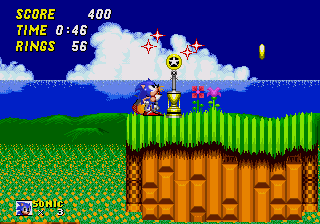Checkpoint
From Sonic Retro
(Redirected from Point Marker)
A checkpoint, first introduced as a lamppost in Sonic the Hedgehog, will save the player's progress throughout a level. The player can restart from an activated checkpoint if they die. Checkpoints also serve as the entrance to a Special Stage in Sonic the Hedgehog 2 and the entrance to a Bonus Stage in Sonic the Hedgehog 3, Sonic & Knuckles and Sonic Mania
Contents
Types of checkpoints
Lampposts
In the original Sega Mega Drive Sonic the Hedgehog and Sonic the Hedgehog CD, the position in the level is saved by Sonic running past a Lamppost[1][2] (or Restart Marker (再スタート・マーカー) in Japan[3][4]), causing the color of the bulb to change from blue to red. The bulb uses the same palette line as Sonic, and the pole uses the same palette line as Rings.
Marker monitors
The 8-bit version of Sonic the Hedgehog and Sonic Blast use Marker[5] monitors, also known as Arrow Monitors[6] (Point Markers (ポイントマーカー) in Japan[7]) as checkpoints. Destroying the monitor creates a checkpoint; however, the current time is not recorded and the player starts with 1:30 minutes after a death.
Marker monitor in Sonic Blast.
Star Posts
The Mega Drive version of Sonic the Hedgehog 2 introduced the Star Post[8] (again called Point Markers (ポイントマーカー) in Japan[9]), with a look quite similar to Sonic 1's Lampposts, except that the bulb is replaced by a star disc. When Sonic or Tails runs past the Star Post, the disc starts flashing and, if the player has enough Rings, revolving stars appear which enable access to a Special Stage.
Sonic the Hedgehog 3 and Sonic & Knuckles also use Star Posts to access the Bonus Stage. In Sonic the Hedgehog 3 & Knuckles, three different types of Bonus Stages can be entered. The Bonus Stage offered by a given Star Post is indicated by the color of the stars, which is determined by how many Rings the player has collected in multiples of 15, starting from 20 Rings:
- Slot Machine: Yellow stars with red border; requires 20-34 Rings.
- Glowing Spheres: Red stars; requires 35-49 Rings.
- Gumball Machine: Silver stars; requires 50-74 Rings.
In Sonic Mania, the player is teleported to a Bonus Stage that varies by game mode. In Mania Mode, Star Posts will transport the player to the Blue Spheres Bonus Stage when at least 25 Rings have been collected, and in Encore Mode they will offer the Pinball Bonus Stage with at least 50 Rings.
Sonic the Hedgehog 4 also uses this version of the checkpoint without the revolving stars.
Star Post in Sonic the Hedgehog 2
Point Markers
Sonic Adventure introduced the 3D Point Marker[10] (ポイントマーカー)[11], two double-lampposts bent at 90-degree angles, with their blue tops facing each other. Running through point markers causes these tops to spin quickly, turn yellow, and bend to a standing straight-up position. For the first time the name of this style of checkpoint was consistent in both Japan and overseas.
Point Markers were also used in Sonic Adventure 2[12] and the 2006 Sonic the Hedgehog[13].
Later games
Most later Sonic the Hedgehog games gave checkpoints which serve little else than to save progress. They take a variety of forms and use different names, but the result is the same.
Sonic Heroes uses Check Points[14] (チェックポイント)[15] indicated by a floating yellow star enclosed in a red circle, though E3 builds such as the GameCube port had the fade effect yellow. These return as Checkpoint Markers in Sonic Rush in the West[16], but are once again called Point Markers (ポイントマーカー)[17] in Japan.
Sonic Advance, Sonic Advance 2 and Sonic Advance 3 simply have Checkpoints[18][19][20] which function similarly to how they did in the original Sonic the Hedgehog. Japan calls them Point Markers (ポイントマーカー)[21][22][23].
Sonic Unleashed and Sonic Colours have "Check Points"[24] or "Checkpoints"[25] which behave similarly to those found in Sonic Adventure.
References
- ↑ File:Sonic1 MD US manual.pdf, page 7
- ↑ File:SonicCD MCD US manual.pdf, page 12
- ↑ File:Sonic1 MD JP manual.pdf, page 20
- ↑ File:SonicCD MCD JP manual.pdf, page 17
- ↑ File:File:SonicBlast_GG_JP_manual.pdf, page 16
- ↑ File:Sonic1 GG US manual.pdf, page 8
- ↑ File:Sonic 1 GG JP Manual.pdf, page 13
- ↑ File:Sonic2 MD US manual.pdf, page 13
- ↑ File:Sonic2 MD JP manual.pdf, page 18
- ↑ File:SonicAdventure DC US manual.pdf, page 11
- ↑ File:SonicAdventure DC JP manual.pdf, page 10
- ↑ File:SonicAdventure2 DC US manual.pdf, page 19
- ↑ File:Sonic06 360 US manual.pdf, page 12
- ↑ File:SonicHeroes GC US manual.pdf, page 27
- ↑ File:SonicHeroes PS2 JP manual.pdf, page 24
- ↑ File:SonicRush DS US manual.pdf, page 20
- ↑ File:SonicRush DS JP manual.pdf, page 26
- ↑ File:SonicAdvance GBA US manual.pdf, page 20
- ↑ File:SonicAdvance2 GBA US manual.pdf, page 22
- ↑ File:SonicAdvance3 GBA US manual.pdf, page 23
- ↑ File:SonicAdvance GBA JP manual.pdf, page 26
- ↑ File:SonicAdvance2 GBA JP manual.pdf, page 27
- ↑ File:SonicAdvance3 WiiUVC manual.pdf, page 19
- ↑ File:Unleashed 360 US manual.pdf, page 16
- ↑ File:SonicColours Wii US manual.pdf, page 17






